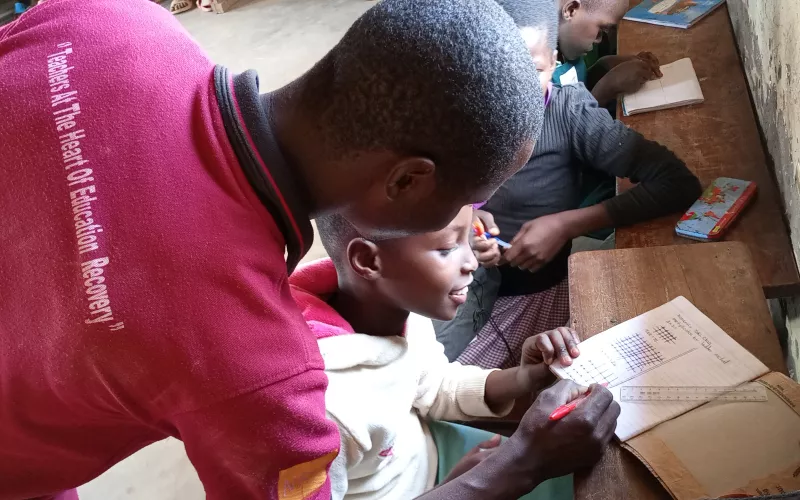
Professional Development of Teachers
Working within the MoES Department of Teacher Education, Coordinating Center Tutors’ major responsibility is to build the capacity of teachers, offer professional and technical support through coaching, mentoring and support supervision.
Shem is among 15 CCTs that VVOB and MoES have invested in their capacity since 2020 as part of the support system for the implementation of TaRL in Uganda. Their involvement as TaRL master trainers reinforces their current role as CCTs whereby they offer technical and mentoring support to teachers.
At the introduction of TaRL in Isingiro, a refugee hosting district, in October 2020, Shem, alongside other key district stakeholders, was identified as a master trainer to support teachers who were going to implement TaRL in their schools. As a master trainer, Shem has had to put on multiple hats.
Shem started training teachers on the TaRL methodology in Isingiro district in 2020. Prior to that, he had been trained by TaRL Africa and VVOB and had an opportunity to undertake TaRL practice classes which grounded him on the TaRL methodology.
He appreciates that the TaRL methodology has a variety of playful practical tasks that promote learning literacy and numeracy in an easy manner. TaRL as well is learner-centered and promotes peer to peer learning and cooperation.
A Math tutor himself, Shem was especially intrigued by the TaRL numeracy activities and aimed at understanding how the methodology would help learners to quickly understand the logic and reasoning behind numeracy operations as opposed to cram work.
According to Shem, TaRL is enjoyable, and learner centered. Real objects are used, and this promotes concrete learning.
TaRL Materials Development and Contextualisation
Throughout the project implementation, Shem has actively participated in the contextualising the TaRL teaching and learning support materials. He was particularly resourceful in the translation of the English calendar chart into Runyankore Rukiga and the proofreading of literacy materials in this language.
Lesson Observation, Mentoring and Monitoring TaRL
During implementation at the classroom level, Shem conducts classroom observations from which he can support teachers through mentoring and coaching. He has helped teachers from 45 schools, use the TaRL methodology effectively, make and use locally available teaching materials, and support teachers to improve their weak areas professionally. With his encouragement, peer-to-peer learning has enabled other teachers to use some TaRL methodology techniques in other classes.
Parental Engagement in Support of TaRL
Beyond classroom engagement, Shem has reached out to the communities to create awareness on the TaRL methodology. This has been done through speaking in churches and attending the Parents and Teachers Association (PTA) and School Management Committee (SMC) meetings. School-specific TaRL assessment data has been shared in these fora encouraging parents to allow their children to participate in TaRL activities.
The TaRL methodology has helped teachers to improve on the teaching of literacy and numeracy. Teachers appreciated TaRL methodology, and the learners find it interesting and practical.
Shem’s Reflections on Adopting TaRL in More Schools
Since 2020, VVOB and MoES have implemented TaRL in 90 refugee and host community government aided schools in Isingiro district. 238 teachers have been trained, and on average 6,149 learners have been reached.
Shem reflects on some lessons he has learnt that would enhance the effectiveness of TaRL when adopted to more schools:
- In numeracy, the practical approach of division and multiplication operations using the TaRL methodology is playful and enables learners to understand Math with ease
- In literacy, the biggest learning challenge observed (for both learners and teachers) was improper pronunciation of words which is then an obstacle to word building. TaRL literacy activities address this challenge by supporting segmentation and blending of letters using letter card, letter jump among other activities, and this makes reading in local language and English easy and interesting
- The ownership of TaRL as an approach to help learners catch up on what they have missed in their literacy and numeracy competences is critical for the adoption of the methodology across more schools. Shem recommends working closely with parents, school management committees, local government leadership such as town clerks and Sub-County chiefs, Primary Teachers Colleges and their CCTs to easily build up a sense of ownership for TaRL in Uganda
The learning achievements of many learners in Uganda are dependent on the decision of education stakeholders to scale interventions that will enable them to catch up on their foundational literacy and numeracy skills. With the support of CCTs and other district-level officials, teacher professional development can be strengthened to help achieve this goal.